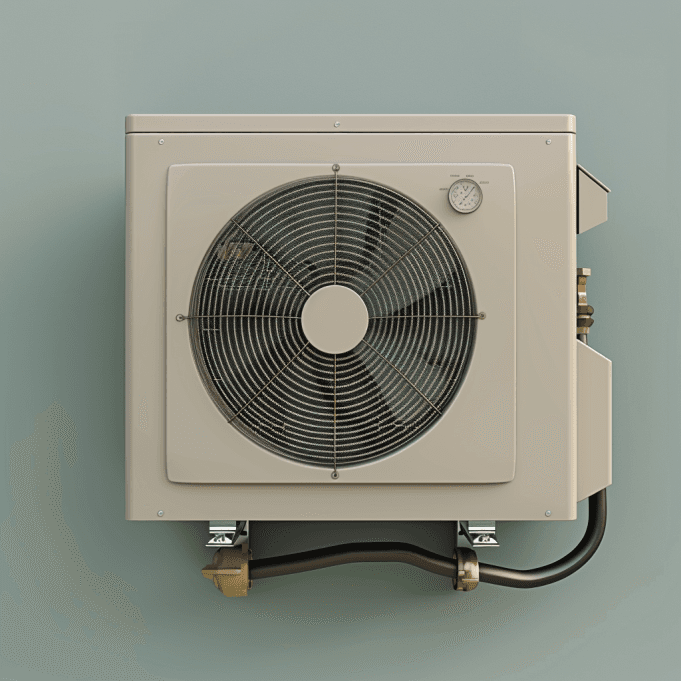
Intro
Imagine your home as a cozy retreat that stays perfectly cool during California’s hot summers and warm in the chilly winters. Heating and cooling aren’t just about comfort; they’re also big energy users, gobbling up almost half of a typical home’s energy! That’s why choosing the right HVAC system is so important.
In this article, we’re breaking down everything you need to know about the different types of HVAC systems out there. Whether you’re upgrading your old setup, building a brand new house, or just curious about how these systems work, we’ve got you covered. From traditional setups like furnaces and central air to modern solutions like ductless mini-splits and eco-friendly geothermal heat pumps, we’ll explore all the options to help you find the best fit for your California home. Ready to learn how you can improve your home’s comfort and cut down on those energy bills? Let’s dive in!
If you want to know about everything faster!
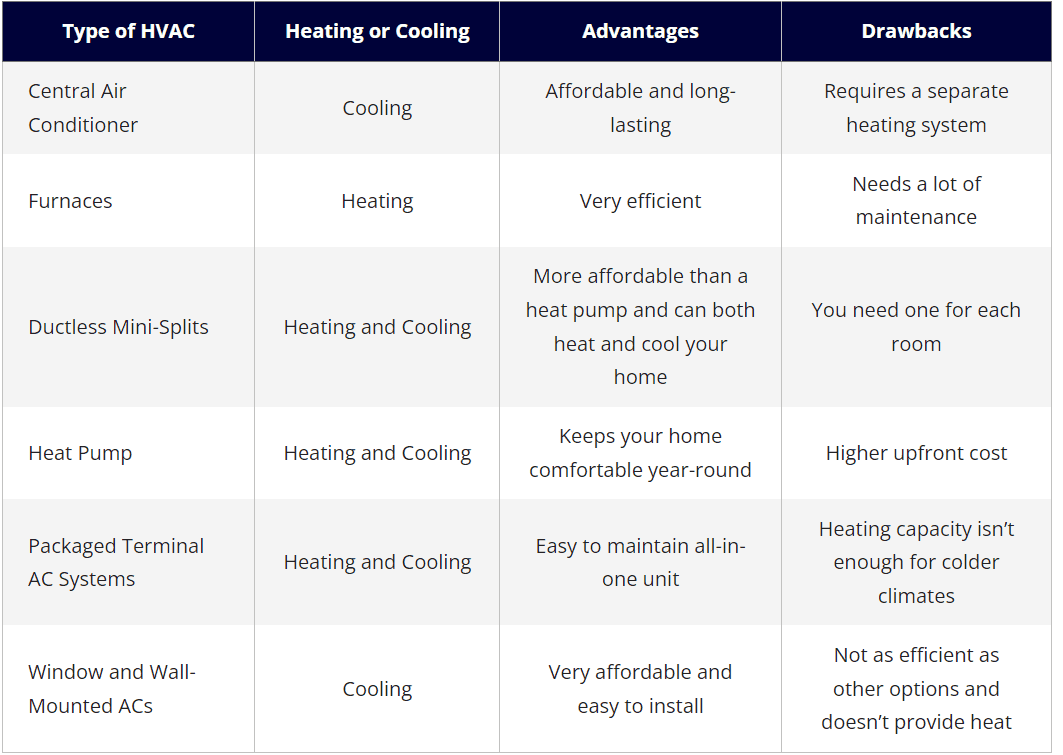
Understanding Heating Systems
Furnaces
A furnace, at its core, is a heating unit intended to distribute warm air throughout a building. It accomplishes this via a ducted warm-air distribution system. Typically powered by electricity, natural gas, or fuel oil, the furnace is a cornerstone of residential heating in many North American homes.
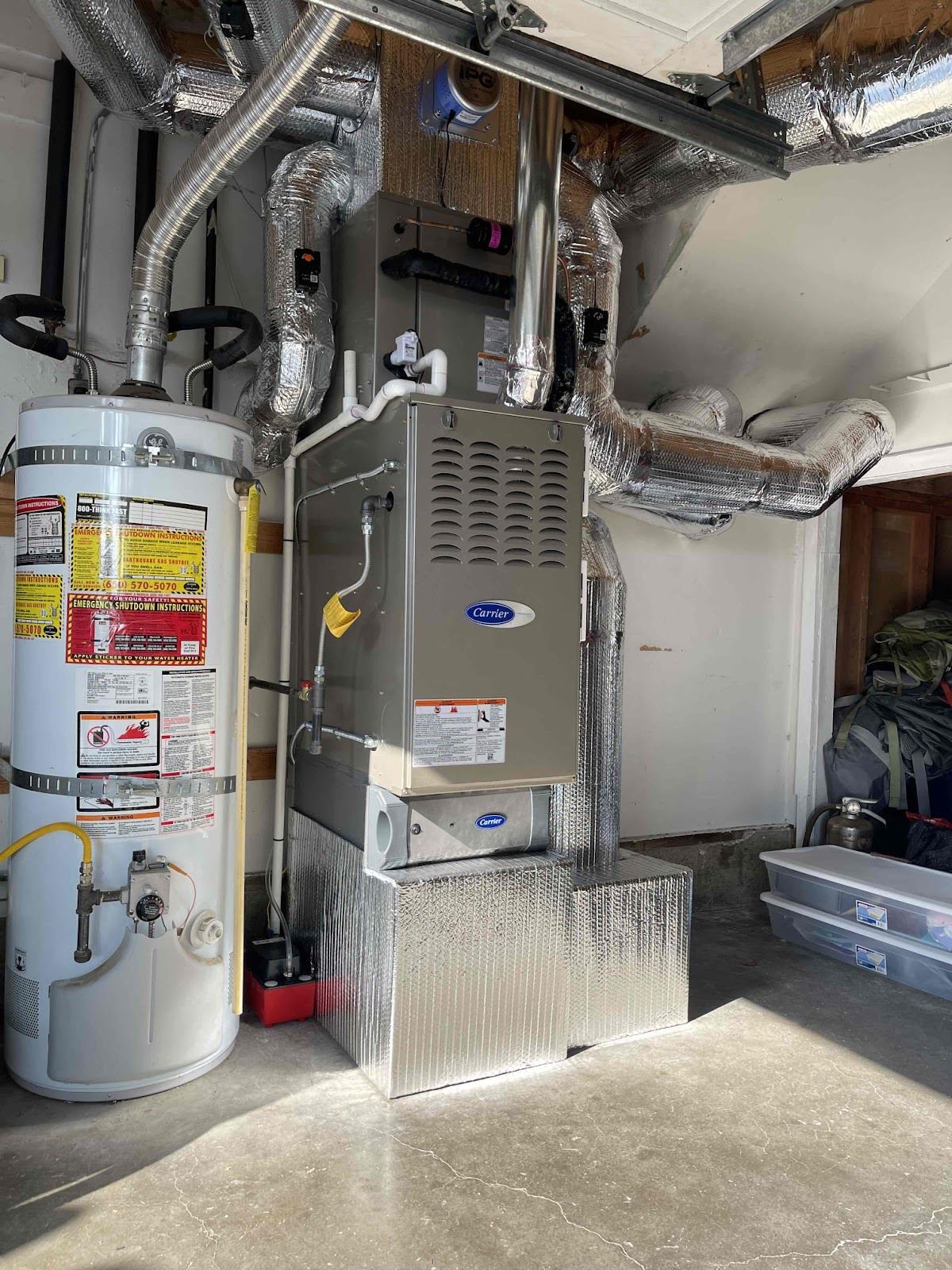
Get to know how IRBIS HVAC installs furnaces by our case studies.
Operation
In operation, a furnace heats the air, which is then propelled by a blower across a network of ducts, dispersing the warm air via registers or grills in various rooms. The process begins in the furnace’s heat exchanger, where the fuel—be it gas, oil, or electricity—combines with air and ignites. The resulting flames heat the metal heat exchanger, and the air handler’s fan pushes the warmed air into the ductwork. For gas or oil-fired systems, combustion byproducts are safely expelled outside through a flue pipe. Modern furnaces enhance efficiency through condensing technology, where exhaust gases cool below 140°F, causing water vapor in the exhaust to condense into water, reclaiming heat that would otherwise escape.
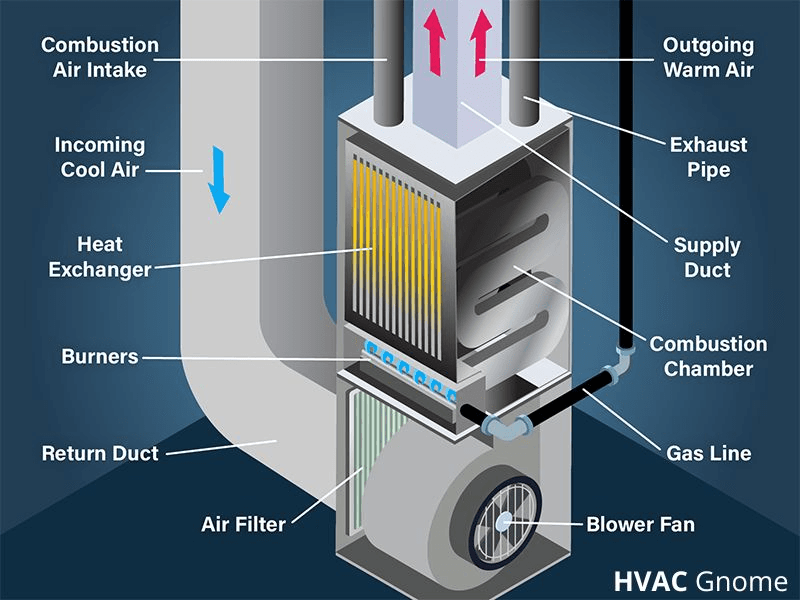
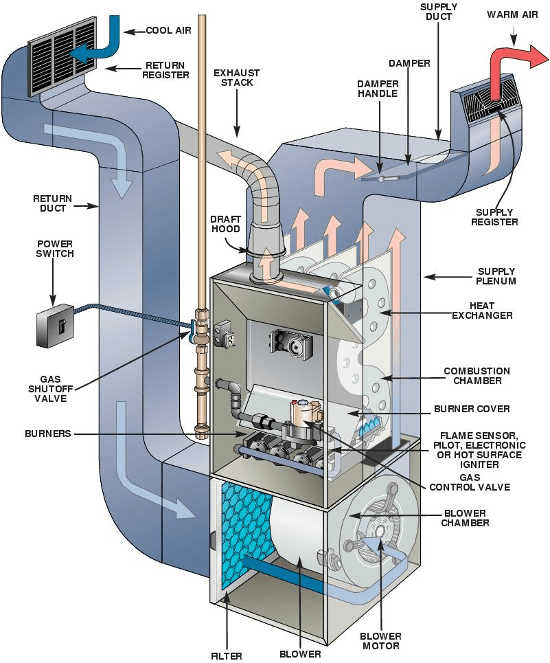
Types of Furnaces
- Gas Furnaces: The most prevalent type, these are celebrated for their efficiency and speed in heating. Gas furnaces can achieve over 90% efficiency with modern technology, utilizing high-efficiency condensing mechanisms that capture escaping heat from exhaust gases.
- Electric Furnaces: These are generally less expensive to install than their gas counterparts and are safer because they don’t rely on combustion, eliminating risks like carbon monoxide poisoning. However, they often lead to higher operational costs due to the price of electricity.
- Oil Furnaces: Less common and typically employed where natural gas isn’t available. While capable of powerful heating, oil furnaces require more maintenance and have higher fuel costs than gas furnaces.
Pros and Cons
| Pros | Cons | |
| Gas Furnace | High efficiency, faster heating, and lower fuel costs compared to oil. | Potential for gas leaks and requires installation of carbon monoxide detectors for safety. |
| Electric Furnace | Lower installation cost, no carbon monoxide risks, very long lifespan. | Higher running costs and potentially less effective in extremely cold climates. |
| Oil Furnace | Effective in areas without gas service, powerful heating capacity. | Effective in areas without gas service and powerful heating capacity. |
Choosing the Right Furnace
Selecting the right furnace involves several considerations:
- Climate: In colder regions, a high-efficiency gas furnace might be preferred due to its powerful heating capability. In milder climates, an electric furnace might suffice due to its simplicity and lower installation costs.
- Availability of Fuel: The choice between gas, oil, or electric furnaces can depend heavily on the availability and cost of these fuels in your area.
- Home Size and Ductwork: The effectiveness of a furnace can also depend on the size of the home and the condition of existing ductwork. Properly sized and well-maintained ducts are crucial for the efficiency of a forced-air system.
When considering a new furnace in California, it’s important to also be aware of the state’s environmental regulations, particularly the recent gas ban. California has been moving towards reducing dependency on fossil fuels, which includes a phased approach to ban the sale of new gas-powered furnaces and other appliances to encourage cleaner, electric alternatives.
Key points to consider in light of the gas ban:
- Future-proofing: Opting for an electric furnace or a heat pump system might be more beneficial as these will comply with future regulations and may also be eligible for state incentives.
- Efficiency and Cost: Modern electric systems are increasingly efficient and may be more cost-effective in the long run due to lower operating costs and potential savings from rebates.
- Environmental Impact: Electric systems generally have a lower environmental footprint, aligning with California’s goals for reducing greenhouse gas emissions.
This shift is part of California’s broader strategy to decrease carbon emissions and promote sustainable energy solutions, making it crucial for homeowners to consider these aspects when selecting a new heating system. Regular maintenance and choosing the right system for your home’s specific needs remain vital to ensure efficiency and comfort.
Heat Pumps
Heat pumps are versatile systems that provide both heating and cooling for your home, making them an increasingly popular choice for efficient year-round climate control. Unlike traditional heating systems that generate heat by burning fuel, heat pumps transfer heat between the inside of a building and the outside air or ground.

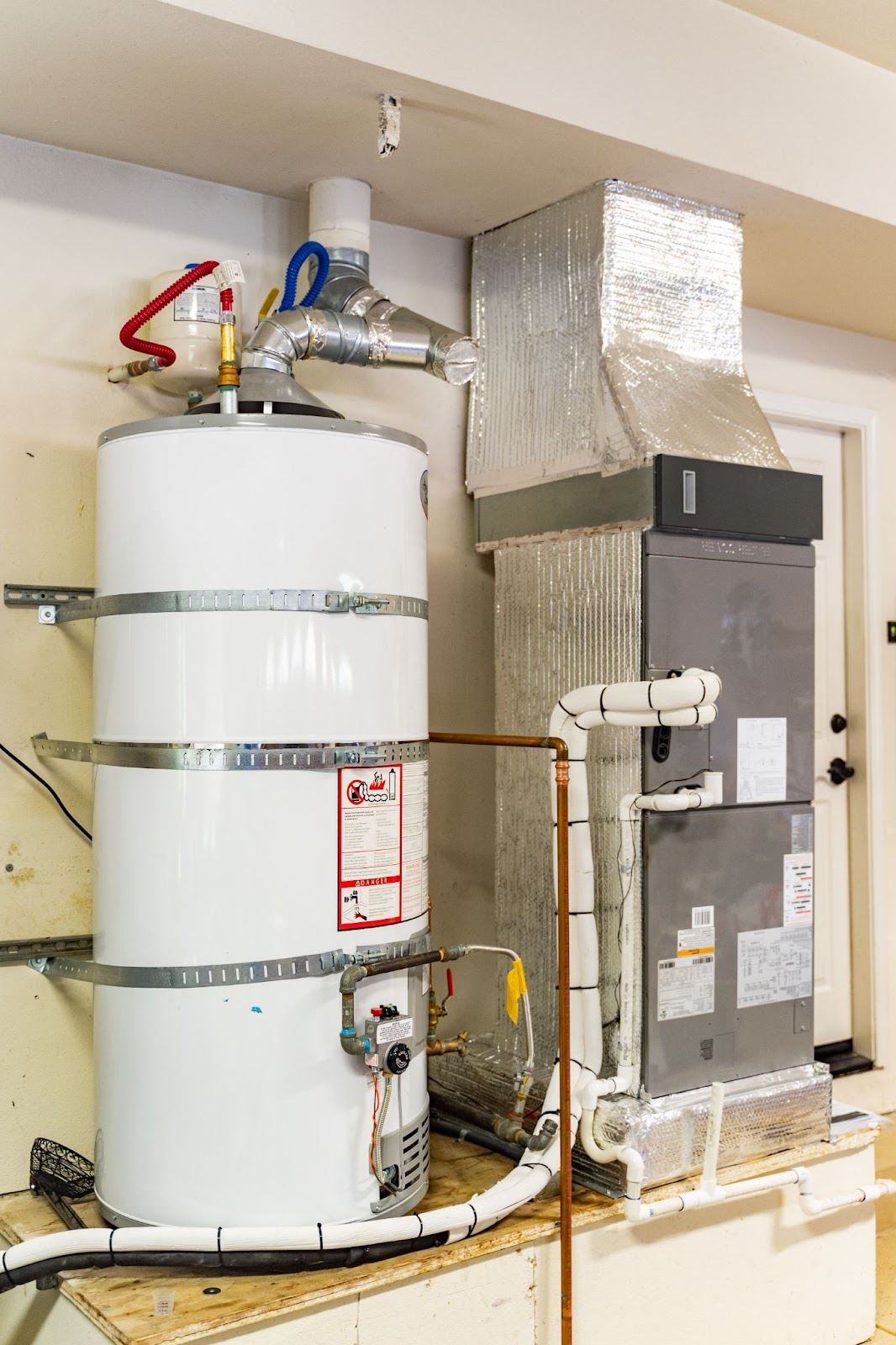
Operation
The fundamental principle behind a heat pump is its ability to move heat from one place to another via a refrigeration cycle, similar to that used in an air conditioning unit. During the winter, heat pumps extract heat from the outdoor air or ground—even in cold temperatures—and transfer it indoors. Conversely, in the summer, they remove heat from the inside of your home to cool it. This dual functionality makes heat pumps an efficient option for regions with moderate climate conditions.
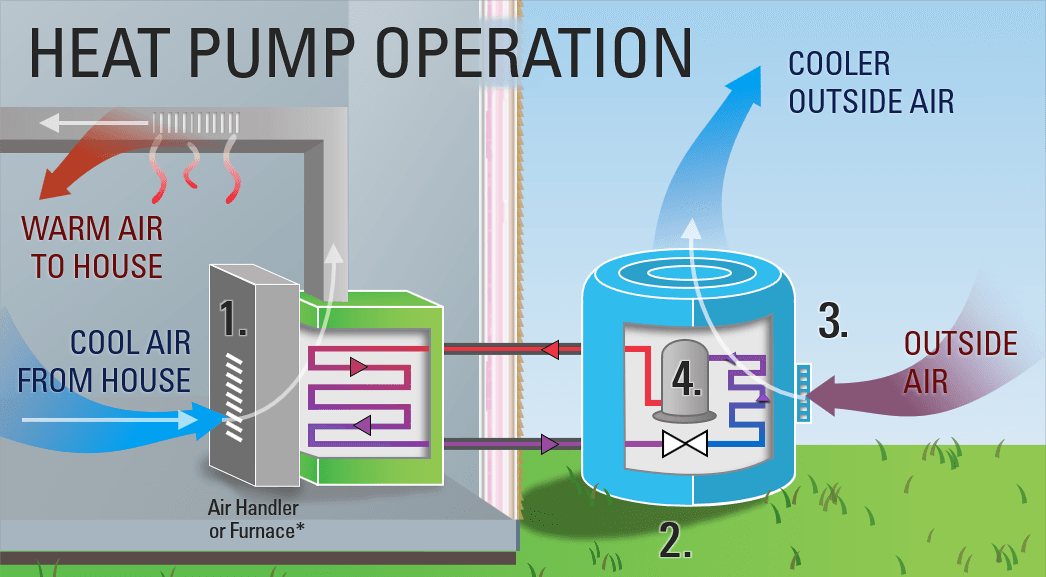
Types of Heat Pumps
- Air-Source Heat Pumps: The most common type, these systems transfer heat between your house and the outside air. Air-source heat pumps are easier to install than ground-source pumps and cost less upfront. However, their efficiency can diminish in extremely cold weather.
- Ground-Source (Geothermal) Heat Pumps: These systems utilize the stable temperature of the ground or groundwater as the exchange medium instead of air. Although more expensive to install, geothermal heat pumps offer significant savings on energy bills over the long term due to their high efficiency and lower operating costs.
Benefits and Limitations
Pros:
- Energy Efficiency: Heat pumps are often more energy-efficient than systems based on combustion. The most efficient heat pumps can deliver one-and-a-half to three times more heat energy to a home than the electrical energy they consume.
- Lower Running Costs: Though the initial investment might be higher, the operating costs are generally lower compared to traditional heating and cooling systems, especially in areas with moderate temperatures.
For a more specific comparison, let’s look at some cost scenarios: Using a standard electricity rate of $0.1319 per kilowatt-hour, running a traditional central AC unit with a capacity of 20,000 BTUs would cost approximately $174.72 per month if it runs continuously. In contrast, a ductless mini split system using 12,000 BTUs would cost about $35.84 a month under the same conditions. So, it saves you $138.88 per month!
- Reduced Carbon Emissions: Since they use electricity and move heat rather than generate it, heat pumps can significantly reduce greenhouse gas emissions, particularly if the electricity is sourced from renewable energies.
- Improved Indoor Air Quality: Heat pumps circulate and filter air, reducing air pollutants, mold, and odors.
Cons:
- Higher Initial Cost: Installing a heat pump system can be more costly than traditional HVAC systems, especially for ground-source heat pumps.
- Less Effective in Extreme Temperatures: Air-source heat pumps can lose efficiency in very cold climates unless they are equipped with a hybrid system that includes a supplementary heating source, like gas or oil.
- Complex Installation: Particularly for geothermal systems, the installation process can be invasive and requires significant space for the ground loop.
Considerations for Choosing a Heat Pump
- Climate: Heat pumps are most effective in areas with mild to moderate climates but can be adapted for colder areas with the right specifications, such as a dual-fuel system that combines a heat pump with a gas furnace.
- Home’s Insulation: Effective insulation significantly enhances the efficiency of a heat pump. Before installation, ensure that your home is well-insulated and airtight.
- Energy Source Availability: While heat pumps run on electricity, considering the availability and cost of electricity versus other fuels in your area can influence the cost-effectiveness of choosing a heat pump system.
Heat pumps represent a forward-thinking solution for homeowners looking for an environmentally friendly way to heat and cool their homes. With their ability to provide comfortable temperatures year-round, lower energy costs, and reduce carbon footprints, heat pumps are a compelling option for modern climate control.
Boilers
Boilers are a traditional heating option widely used across the United States, particularly in older homes and buildings in the Northeast and Midwest states. These regions often favor boiler systems due to their ability to provide efficient heating in areas that experience harsh, cold winters. Boilers operate by circulating hot water or steam through a system of pipes to radiators, baseboard heaters, or underfloor heating systems, offering consistent, high-quality heat.
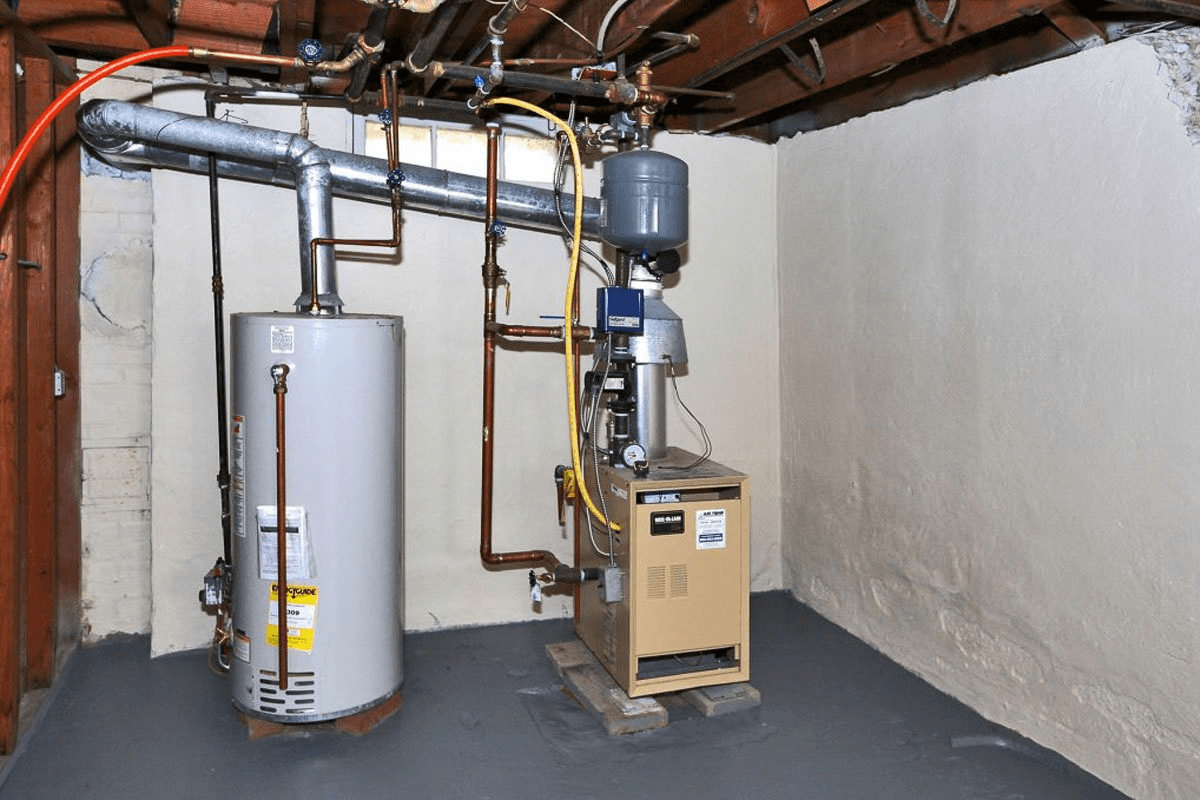
Operation
Compared to the air-forced systems, boilers heat water, providing either hot water or steam for heating. Steam is distributed via pipes to steam radiators, while hot water can be circulated to radiators or through a radiant floor system. The hot water returns to the boiler to be reheated and recirculated. Boilers operate more efficiently than many other heating units because they don’t require the use of blowers and duct systems, which can lose a lot of energy through heat dissipation.
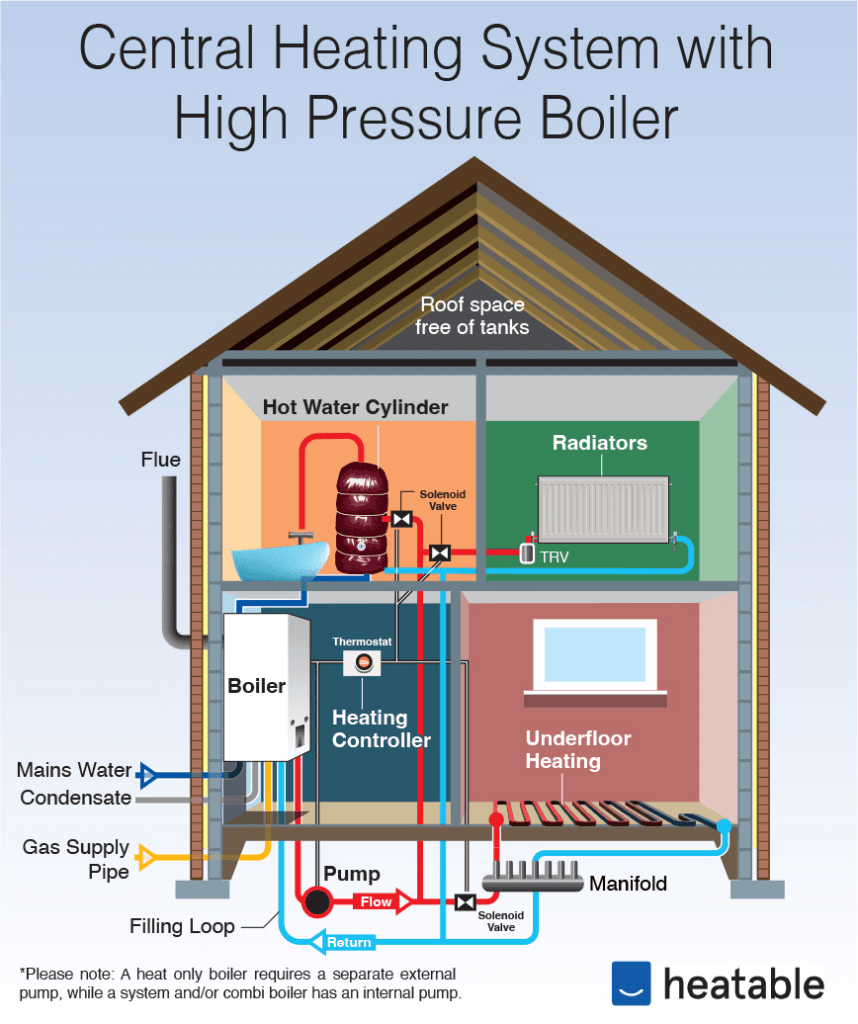
Types of Boilers
- Steam Boilers: These generate steam by heating water beyond the boiling point. They tend to be used in older homes and can operate at higher pressures than hot water boilers.
- Hot Water Boilers: These heat water to temperatures below boiling, to be pumped through the home’s radiators or radiant floor systems. They are more common than steam boilers and are generally more efficient.
Benefits and Limitations
Pros:
- Comfortable Heat: Boilers provide radiant heat, which many find more comfortable than the forced-air heat from a furnace. The heat from a boiler is not associated with the draftiness or uneven temperatures sometimes created by forced-air systems.
- Silent Operation: Boilers operate very quietly compared to furnaces because they don’t use blowers.
- Improved Air Quality: Boilers don’t circulate dust and allergens since there are no air ducts involved. This feature makes boilers particularly beneficial for allergy sufferers.
- Durability: Boilers generally last longer than furnaces, with fewer moving parts to malfunction.
Cons:
- Higher Installation Costs: Installing a boiler system can be more expensive than installing a furnace. The initial investment may be higher, particularly for systems like radiant floor heating.
- Slower Heat Increase: Boilers take longer to heat up and begin distributing heat compared to forced-air systems.
- Maintenance: While generally reliable, boilers do require regular maintenance to prevent leaks and to ensure valves and pumps are functioning properly.
Considerations for Choosing a Boiler
- Fuel Type: Boilers can operate on natural gas, oil, propane, or electricity. The choice of fuel can affect operating costs and efficiency, so it’s essential to compare fuel costs in your area.
- Space Requirements: Boilers need enough space for the water tank and the system itself, which can be more substantial than a furnace setup.
- Energy Efficiency: Modern boilers have various energy efficiency ratings. High-efficiency models can convert up to 90% or more of their fuel into heat, making them highly cost-effective in the long run.
Boilers are a robust heating solution, ideal for creating a comfortable, warm home environment. They are particularly effective in cold climates where consistent heat is necessary. By choosing the right boiler for your home and ensuring it is maintained correctly, you can enjoy efficient and effective heating for many years.
Exploring Cooling systems
Central Air Conditioning
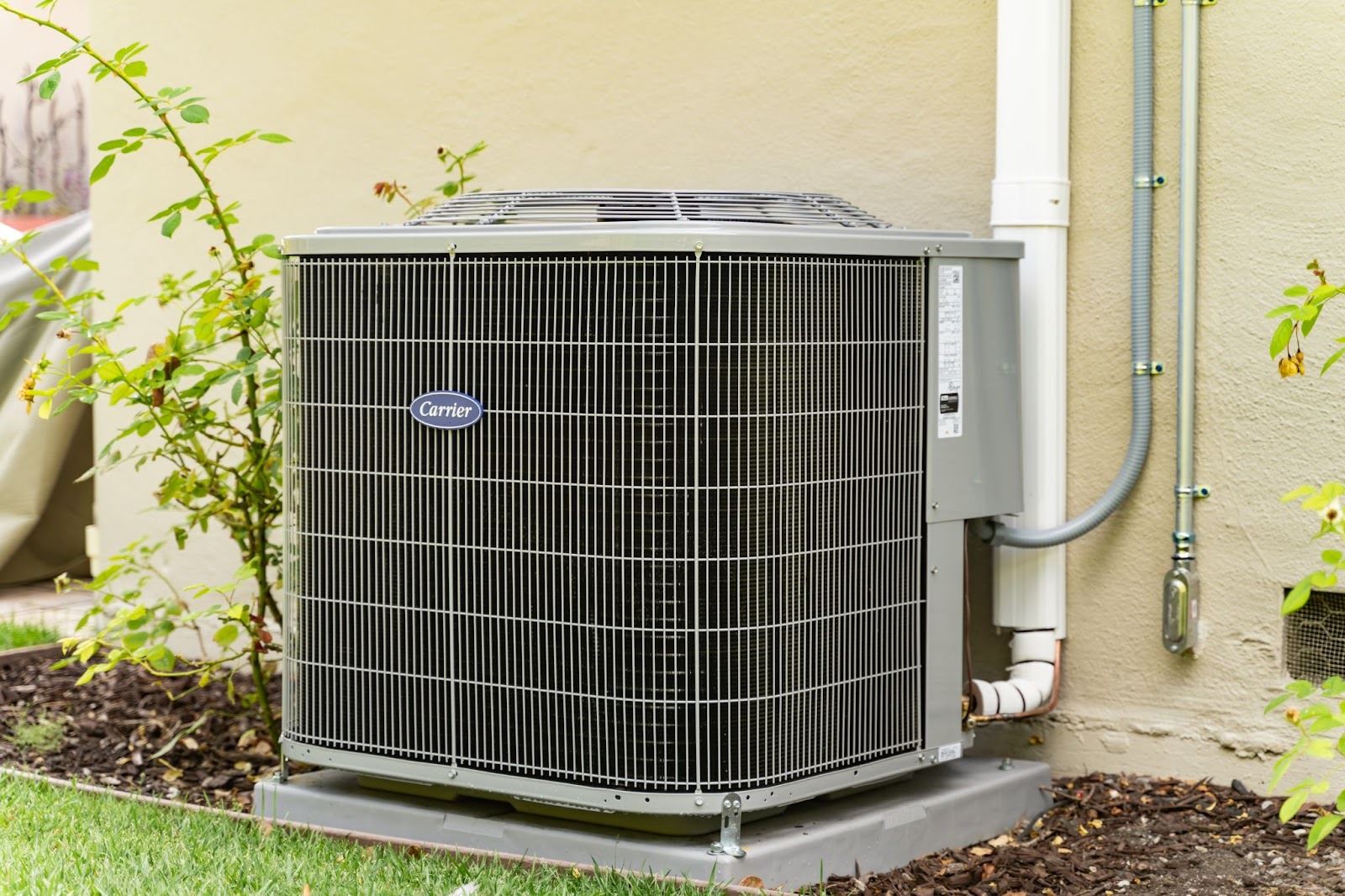
Central air conditioning systems are a prevalent choice for residential and commercial buildings seeking efficient and comprehensive cooling solutions. These systems cool air centrally and distribute it throughout the entire structure via a network of ducts, providing uniform cooling across multiple rooms or zones.
Operation and Components
A central air conditioning system is composed of several key components that work together to effectively cool your home:
- Evaporator Coil: Located inside the home, usually in conjunction with the furnace or air handler, the evaporator coil cools the air as it passes over it. The coil contains refrigerant that absorbs heat from the indoor air.
- Condenser Coil: Typically situated outside the home, the condenser coil releases the accumulated heat from the indoor air outside.
- Compressor: Also located in the external unit, the compressor is the heart of the air conditioning system, circulating the refrigerant between the evaporator and condenser coils.
- Blower: Found within the air handler or furnace, the blower circulates air across the evaporator coil and then distributes it through the ductwork of the home.
- Thermostat: This component acts as the system’s control center, allowing homeowners to set the desired temperature, which the air conditioning system then maintains.
How They Function Together
The process begins when warm indoor air is pulled into the air conditioning system through return air ducts and passed over the cold evaporator coil. The refrigerant inside the evaporator coil absorbs the heat from the air, cooling it. The cooled air is then pushed back into the house through the duct system while the heated refrigerant is transferred to the compressor. The compressor pumps the refrigerant to the condenser coil, where it releases its heat to the outside air, cooling down before cycling back to the evaporator to absorb more heat. This cycle continues until the indoor air reaches the temperature set on the thermostat.
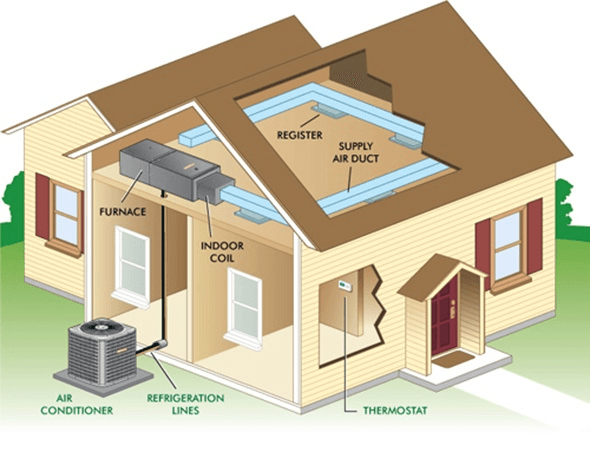
Advantages
- Efficient Cooling: Central air conditioners are highly efficient and can quickly cool entire buildings uniformly.
- Improved Air Quality: As the air is circulated through the system, it passes through air filters that remove airborne particles such as dust and lint, enhancing indoor air quality.
- Programmable and Automatable: Modern systems can be programmed for different temperatures at different times of the day or operated remotely, increasing convenience and energy efficiency.
Disadvantages
- Initial Cost: Installation of a central air conditioning system can be costly, particularly if ductwork needs to be installed or upgraded.
- Maintenance Requirements: To keep them running efficiently, central AC systems require regular maintenance, including filter changes and duct cleaning.
- Energy Consumption: While modern systems are energy-efficient, central air conditioning still consumes more energy than smaller, localized cooling units.
In summary, central air conditioning systems offer a powerful and efficient way to cool entire homes or buildings. They provide a level of comfort and air quality that smaller units cannot match, though they come with higher initial installation and maintenance costs. For homeowners looking for a reliable, whole-home cooling solution, a central air conditioning system remains one of the best options available, especially in regions with high temperatures and humidity levels.
Ductless Mini-Split Systems
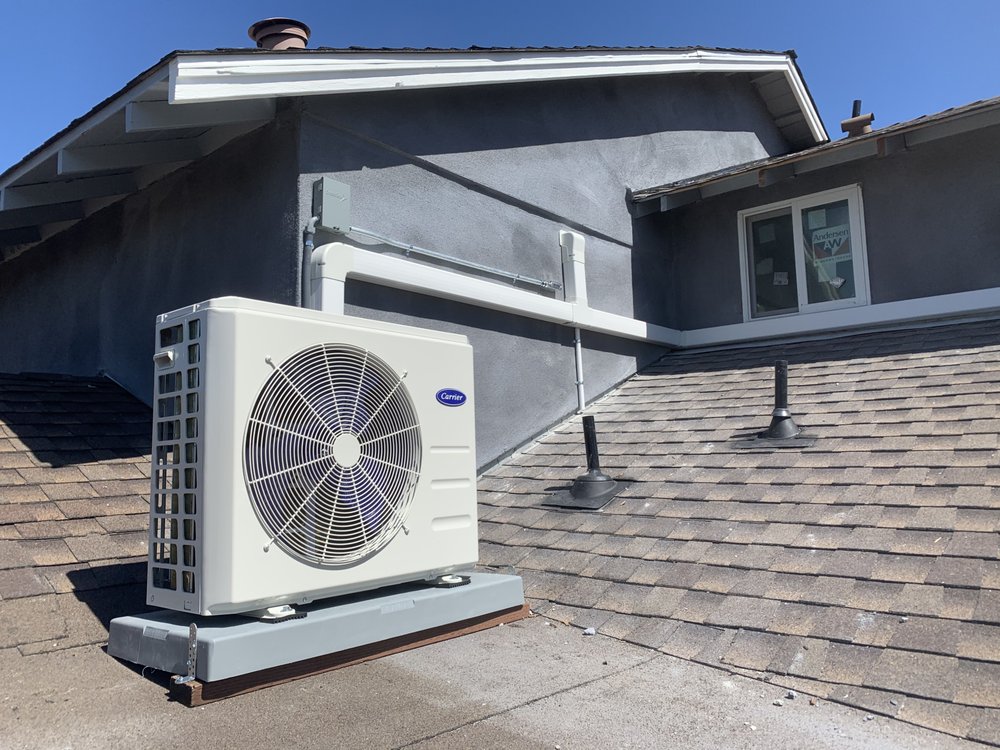
Ductless mini-split systems are gaining traction in the U.S., revolutionizing the way we heat and cool our homes. With a 16% annual increase in sales leading up to 2018, these innovative systems now claim nearly 15% of the overall US HVAC market. Ideal for room additions, renovations, and homes without existing ductwork, mini-splits offer efficient, customizable comfort without the complexities of traditional ducted systems. They’re particularly useful in homes with hard-to-condition spaces like sunrooms or bonus rooms over garages. Additionally, their precise temperature control capabilities make them an excellent choice for maintaining the ideal climate in specialized environments like wine cellars, ensuring that delicate vintages are kept in perfect conditions. As more homeowners discover these benefits, the popularity of mini-splits continues to soar, reflecting their increasing role in modern home climate control.
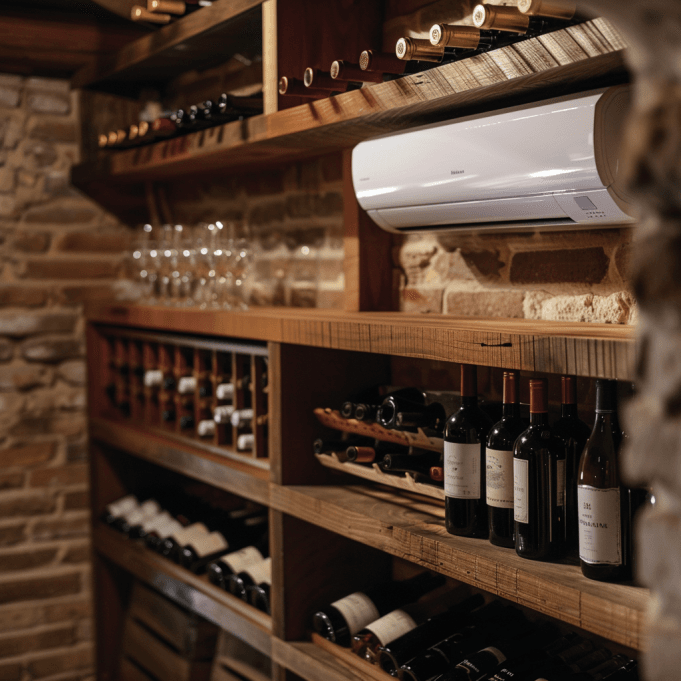
Definition and Operation
A ductless mini-split system consists of two main components: an outdoor compressor/condenser and one or more indoor air-handling units. These components are connected by a conduit that houses the power cable, refrigerant tubing, suction tubing, and a condensate drain. The system operates on a simple principle: the outdoor unit compresses and condenses the refrigerant, which is then piped to the indoor units where it evaporates, cooling the air inside the room. In heating mode, the process is reversed, and the system extracts heat from the outside air to warm the indoor space.
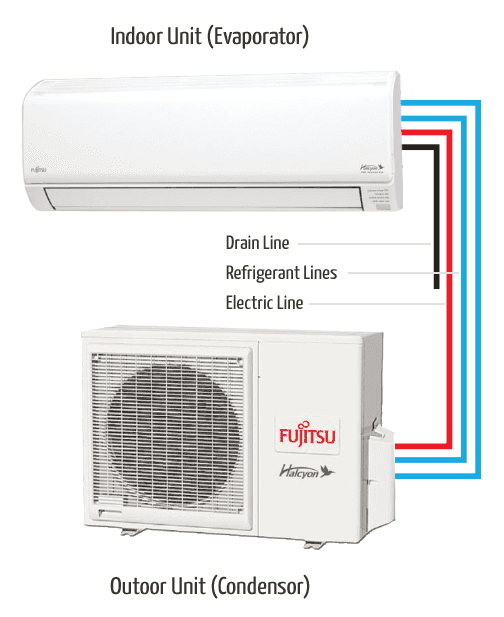
Installation Process
The installation of a ductless mini-split system is relatively straightforward and less invasive than installing traditional ducted HVAC systems. The indoor unit is typically mounted on the wall and connected to the outdoor unit through a small hole in the wall, which minimizes the disruption to existing structures. This setup allows for flexible placement of the indoor units to target specific areas for heating or cooling.
Ideal Use Cases
Ductless mini-split systems are ideal for:
- Additions or renovations where extending or installing new ductwork is impractical or too expensive.
- Homes without existing ductwork, such as those with hydronic heat or electric baseboard heating.
- Individual rooms or zones within a larger home that have specific temperature control needs, allowing for personalized comfort and enhanced energy efficiency.
Advantages Over Traditional Central A/C
- Energy Efficiency: Ductless mini-split systems avoid the energy losses associated with ductwork, which can account for more than 30% of energy consumption for space conditioning, especially if the ducts are in an unconditioned space such as an attic.
- Individual Zoning: Each indoor unit can be controlled independently, allowing for precise temperature control in different areas or rooms. This not only improves comfort but also reduces energy waste by heating or cooling only the areas that are in use.
- Ease of Installation: The lack of ductwork simplifies the installation process significantly, making ductless systems less disruptive and often less expensive to install in terms of labor and materials.
- Aesthetic Flexibility: With various styles of indoor units available, including wall-mounted, ceiling-recessed, and floor-standing models, ductless mini-splits can be integrated more seamlessly into a room’s decor compared to bulky window units or portable air conditioners.
However, they also come with some disadvantages when compared to traditional central air conditioning systems:
- Aesthetic Impact: Mini-splits include indoor units that are mounted on the wall or ceiling, which may not blend seamlessly into every decor. In contrast, traditional central AC systems are mostly out of sight, with only vents visible.
- Initial Cost: While mini-splits can be more energy-efficient, the initial installation cost can be higher, especially when multiple indoor units are required for different rooms or zones.
- Maintenance Challenges: Each indoor unit of a ductless system requires its own maintenance, including cleaning and filter changes, which can be more cumbersome compared to a single air handler in a central AC system.
- Limited Heating Capability: Although many mini-splits come with heat pump functionality, they might not be as effective in extremely cold climates as traditional systems, which can be supplemented with furnaces for combined heating solutions.
- Potential for Inconsistent Cooling: If not properly sized and installed, mini-splits can lead to inconsistent cooling or heating in different areas of the home, unlike central systems that provide a more uniform distribution of conditioned air.
When to Choose Ductless Over Central AC
Choosing a ductless mini-split over traditional central AC might be wise when:
- Adding to or modifying an existing home where adding new ductwork would be too complex or costly.
- Seeking to reduce overall energy consumption by avoiding the inefficiencies associated with ducted systems.
- Desiring individual control over the climate in different rooms or zones, which can cater to the varying preferences of household members and different usage patterns throughout the day.
In summary, ductless mini-split systems offer a versatile and efficient alternative to traditional central air conditioning systems, providing customizable solutions that can meet a wide range of heating and cooling needs. Whether for a new addition, an upgrade in an older home, or simply for more precise climate control, ductless mini-splits are worth considering for their many benefits and modern technology.
Evaporative Coolers (Swamp Coolers)
Evaporative coolers, also known as swamp coolers, are highly effective in hot, dry climates where they utilize the natural process of evaporation to cool indoor spaces. These systems are especially suited for areas with low humidity because they rely on the ability of dry air to absorb moisture. As the air absorbs water, it cools down, providing a natural and energy-efficient cooling method.
In the United States, states where swamp coolers are particularly effective include:
- Arizona: Known for its desert climate, Arizona has the ideal dry and hot conditions that make evaporative coolers an excellent choice for cooling homes.
- Nevada: Similarly, Nevada’s arid regions are perfect for swamp coolers, which can use the dry air to enhance cooling efficiency.
- New Mexico: This state also benefits from the dry heat, where swamp coolers are often used instead of traditional air conditioning systems.
- Colorado: Particularly in the more arid parts of the state, homeowners often opt for evaporative coolers to keep their homes comfortable during the hot months.
- Utah: With its desert and semi-arid climate zones, Utah is another state where swamp coolers are effective and widely used.
These coolers are less effective in humid climates because the air has less capacity to hold additional moisture, which diminishes the cooling effect. Therefore, in states with higher humidity, traditional air conditioning systems are usually more appropriate.
Definition and Operation
An evaporative cooler works by pulling hot, dry air through moist pads. As the air passes over these pads, water evaporates, which absorbs heat from the air, effectively lowering the temperature. The cooled air is then circulated through the building using a fan. This system relies on a constant supply of fresh outside air and works best when the outside air is dry, and humidity levels are low.


The main components of an evaporative cooler include:
- Water reservoir: Holds the water needed for the evaporation process.
- Pump: Circulates water from the reservoir to the cooling pads.
- Cooling pads: Made from materials that absorb and hold water, facilitating efficient evaporation.
- Fan: Blows air through the moist pads and into the space being cooled.
Efficiency in Dry Climates
Evaporative coolers thrive in dry climates for several reasons:
- Energy Efficiency: They consume significantly less electricity compared to conventional air conditioners, as they only require power for the fan and water pump, not for energy-intensive compressors.
- Cost-Effective: Lower energy consumption translates to reduced energy bills. Additionally, the initial purchase and installation costs are generally lower than those for traditional air conditioning systems.
- Environmental Impact: Evaporative coolers do not use refrigerants, which can be harmful to the environment. This makes them a more eco-friendly option for cooling homes.
Operational Overview
To maintain effectiveness, it’s important to ensure that windows or doors are partially open in rooms being cooled to allow for continuous air flow. This helps to keep the air fresh and prevents humidity from building up inside the home, which can diminish the cooling effect.
Regular maintenance of an evaporative cooler involves cleaning the pads, reservoir, and pump, and ensuring the fan is in good working order. This helps to maximize the efficiency and lifespan of the cooler.
When to Use as an Alternative to Traditional AC
Evaporative coolers are best used as an alternative to traditional AC systems in the following scenarios:
- Geographic Suitability: In areas with low humidity and high temperatures, such as the southwestern United States, evaporative coolers can provide effective and economical cooling.
- Ventilation Requirements: Homes that can accommodate open windows and doors, which are necessary for the optimal operation of evaporative coolers, will benefit most from this type of system.
- Economic Considerations: For those looking to reduce energy costs and minimize environmental impact, evaporative coolers present a compelling alternative.
- Health and Comfort: They can be preferable for people sensitive to the dry air produced by traditional air conditioners, as evaporative coolers increase indoor humidity.
In summary, evaporative coolers provide an efficient cooling solution in appropriate climates, offering significant cost savings and environmental benefits. Ideal for regions with low humidity, these systems enhance comfort while keeping energy consumption to a minimum. When considering cooling options, particularly in suitable dry areas, evaporative coolers should be on the list for their unique advantages over traditional air conditioning methods.
Hybrid Heating and Cooling Systems
Hybrid heating and cooling systems, also known as dual-fuel systems, represent a versatile and efficient approach to temperature control in homes and buildings. These systems combine two different types of technology to provide a cost-effective, energy-efficient, and reliable solution for year-round comfort.
What Are Hybrid Systems?
Hybrid systems integrate the strengths of two different heating and cooling mechanisms, typically pairing a heat pump with a traditional gas or oil furnace. This combination allows the system to switch between energy sources based on external temperatures and internal heating demands, optimizing efficiency and operational costs.
How They Function
The primary component of a hybrid system is usually a heat pump, which operates like a standard air conditioner in the summer but can reverse its function in the winter to heat the home. Heat pumps are highly efficient because they transfer heat rather than generate it by burning fuel. However, their efficiency can drop in extremely cold weather, making it difficult for them to extract sufficient warmth from the outside air.
This is where the second component of a hybrid system—the furnace—comes into play. When temperatures drop to a point where the heat pump may no longer operate efficiently or cost-effectively, the system automatically switches to the furnace. This switch can be set to occur at a specific outdoor temperature, known as the “balance point,” which is determined by the relative cost and efficiency of the two fuel sources.

Examples of Hybrid Setups
- Heat Pump with Gas Furnace Backup: This is one of the most common hybrid setups. Here, the heat pump provides both heating and cooling for most of the year. However, during extreme cold spells, the system switches to the gas furnace, which can heat the home more effectively and efficiently under those conditions.
- Heat Pump with Oil Furnace Backup: Similar to the gas furnace setup, this system uses an oil furnace as the backup heating source. It’s particularly common in areas where natural gas is not readily available.
Energy Efficiency
Hybrid systems are designed to offer maximum energy efficiency. Heat pumps alone are known for their efficiency, providing several times more heating or cooling energy than the electrical energy they consume. By combining a heat pump with a furnace, hybrid systems leverage the most efficient heating mode possible based on current weather conditions and energy prices, which can lead to significant savings on utility bills.
Considerations for System Optimization
- Correct Sizing and Installation: Proper sizing and installation of both the heat pump and furnace components are critical. An oversized or undersized system can lead to inefficient operation and energy waste. It’s essential to work with a qualified HVAC professional who can assess your home’s heating and cooling needs.
- Thermostat Settings: To maximize efficiency, it’s crucial to set the balance point correctly. This is the temperature at which your system switches from the heat pump to the furnace. Setting this balance point too high or too low can lead to unnecessary energy use and increased costs.
- Regular Maintenance: Regular maintenance is vital to ensure that both components of a hybrid system are functioning efficiently. This includes annual check-ups, replacing filters, and ensuring that ducts are sealed and insulated where necessary.
- Energy Assessments: Periodic energy assessments can help identify whether your system is operating optimally or if adjustments are needed to improve efficiency and comfort.
In conclusion, hybrid heating and cooling systems offer a flexible and energy-efficient solution for maintaining comfortable indoor temperatures throughout the year. By intelligently switching between a heat pump and a furnace, these systems provide cost-effective comfort regardless of the weather outside. Homeowners considering a new HVAC system or looking to upgrade an existing one should consider the long-term benefits of a hybrid system, particularly in regions with significant seasonal temperature variations. As a heating alternative, hybrid systems stand out for their efficiency and adaptability.
Rooftop Units
Rooftop units, commonly abbreviated as RTUs, are an essential part of the HVAC landscape, particularly in commercial buildings. They provide heating, ventilation, and air conditioning (HVAC) to large spaces such as office buildings, retail stores, schools, and manufacturing facilities. Mounted on rooftops, they offer a centralized climate control solution that minimizes indoor space usage while delivering efficient and effective heating and cooling.
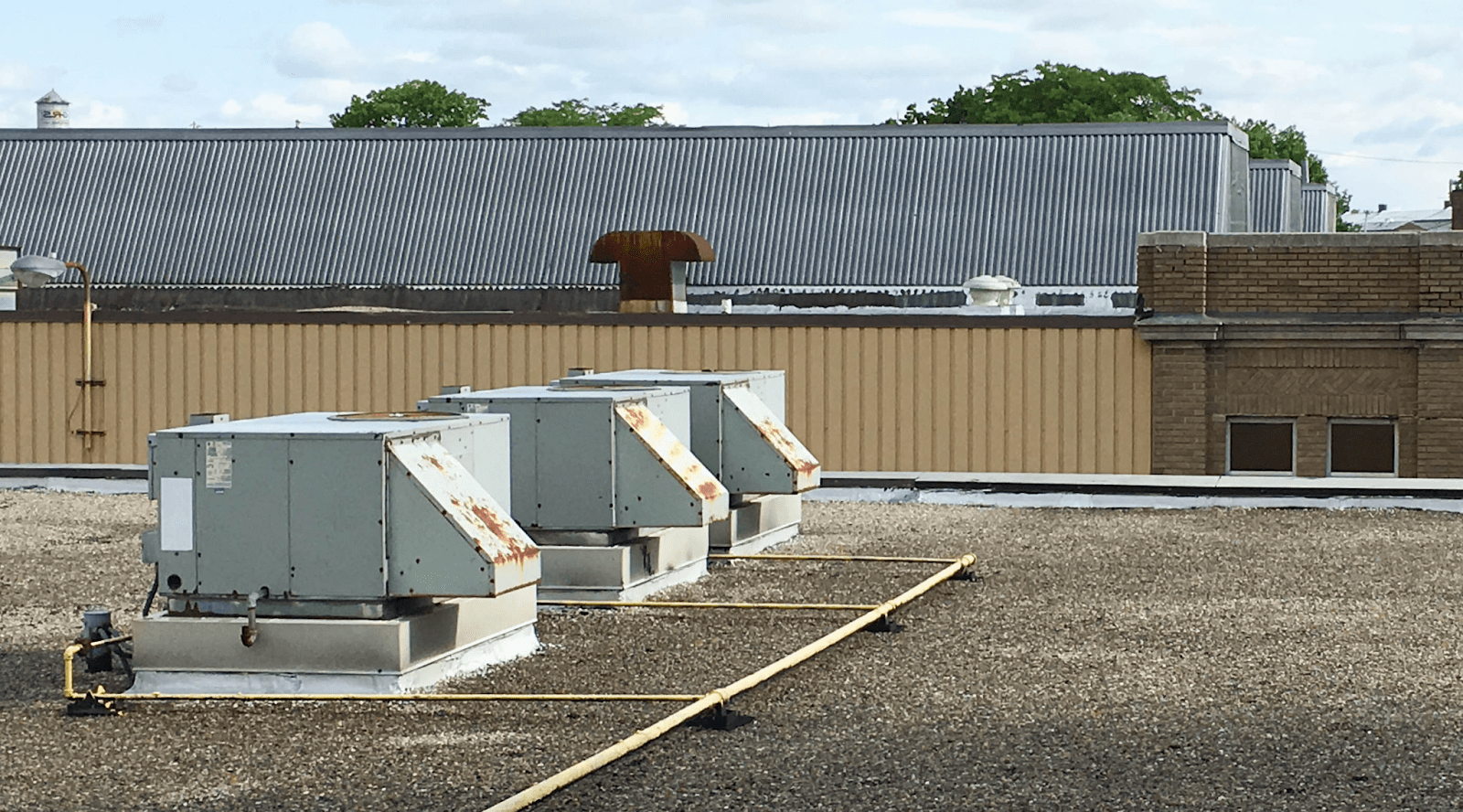
We’ll explore the basics of rooftop units, delve into their operational principles, discuss the various types available, and weigh the pros and cons. We’ll also offer guidance on how to choose the right rooftop unit for your needs.
Operations
Rooftop units function similarly to other HVAC systems but are specially designed for rooftop installation. Here’s a step-by-step overview of how they operate:
- Air Intake: Fresh outdoor air is drawn into the RTU via dampers. The air can also be mixed with return air from the building, depending on the desired indoor air quality and ventilation requirements.
- Filtration: The incoming air is filtered to remove dust, pollen, and other particulates, ensuring clean air supply.
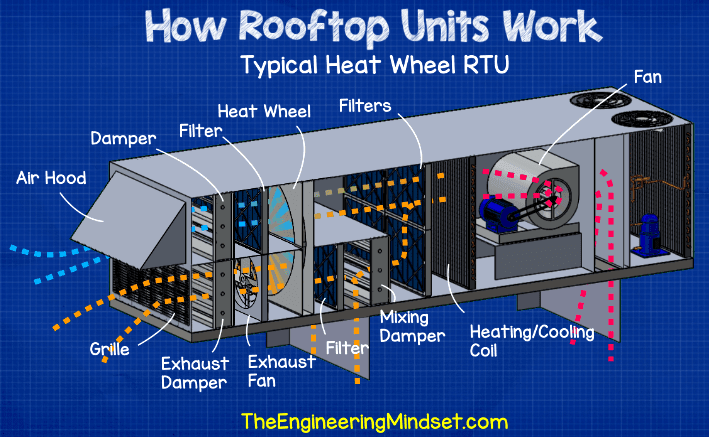
Heating/Cooling
- Cooling Mode: In the cooling mode, a refrigerant circulates through a coil, absorbing heat from the air. The cooled air is then distributed through the building.
- Heating Mode: During heating, a gas burner or electric heating coil warms the air.
- Air Distribution: The conditioned air is delivered to the interior space through a ductwork system, while the return air is recirculated or expelled outside.
- Ventilation: Exhaust fans expel stale air while maintaining appropriate indoor air quality.
- Control System: Modern RTUs are equipped with control systems that monitor and adjust temperature, humidity, and airflow based on the building’s requirements.
Types of Rooftop Units
Rooftop units come in various configurations, catering to diverse commercial HVAC needs:
Single-Zone RTUs:
- Suitable for smaller buildings or single-use spaces.
- Controlled by a single thermostat.
- Economical but limited in temperature control flexibility.
Multi-Zone RTUs:
- Ideal for buildings with multiple zones requiring different temperatures.
- Utilize dampers or VAV (Variable Air Volume) systems to regulate airflow and temperature.
Gas/Electric RTUs:
- Provide both gas heating and electric cooling.
- Commonly used in areas where natural gas is readily available.
Heat Pump RTUs:
- Efficient in moderate climates.
- Provide both heating and cooling via a reversible refrigerant cycle.
Variable Air Volume (VAV) RTUs:
- Adjust airflow to meet the demand in various zones.
- Improve energy efficiency and comfort.
Packaged Heat Recovery Units:
- Integrate heat recovery systems to improve energy efficiency by capturing waste heat.
Dedicated Outdoor Air Systems (DOAS):
- Focus exclusively on ventilation, supplying 100% outdoor air.
Pros and Cons of Rooftop Units
Pros
- Space Efficiency: Free up indoor space by utilizing the rooftop.
- Centralized System: Simplifies installation and maintenance.
- Versatility: Available in various configurations to meet specific needs.
- Energy Efficiency: Advanced controls and zoning options reduce energy consumption.
- Quick Installation: Factory-assembled and pre-wired for faster setup.
Cons
- Accessibility: Difficult to access in poor weather conditions or for large buildings.
- Weight: May require structural reinforcement of the roof.
- Noise: Can produce significant noise if not properly insulated.
- Cost: High upfront costs, especially for advanced models.
Choosing the Right Rooftop Unit
Selecting the appropriate rooftop unit depends on several factors:
Building Size and Usage
- Determine the building’s square footage and the intended use of the space.
- Larger buildings or multi-use spaces may require multi-zone RTUs or VAV systems.
For buildings over 50,000 square feet, multi-zone RTUs or VAV systems are preferred to ensure efficient temperature control.
Climate
- Heat pump RTUs are ideal for moderate climates.
- Gas/electric units work well in regions with distinct seasons.
According to the Department of Energy, heat pump RTUs can reduce energy consumption by up to 40% in moderate climates compared to traditional gas/electric units.
Energy Efficiency
- Look for units with high SEER (Seasonal Energy Efficiency Ratio) or EER (Energy Efficiency Ratio) ratings.
- Consider models with heat recovery or economizer features.
An RTU with a SEER rating of 14 is approximately 25% more efficient than one with a rating of 10, resulting in significant energy savings over time.
Control System
- Modern RTUs with advanced control systems can optimize energy use.
- Integration with building management systems is beneficial.
Buildings using advanced RTU control systems report energy savings of 20-30%, as per a study by the Pacific Northwest National Laboratory.
Budget
- Balance between upfront costs and long-term operational savings.
- Consider available rebates or incentives for energy-efficient models.
While energy-efficient RTUs may cost up to 20% more initially, utility rebates and energy savings often result in a payback period of fewer than five years.
Maintenance Requirements
- Opt for units with accessible components for easy servicing.
- Regular maintenance can significantly extend the lifespan of the unit.
Properly maintained RTUs can last up to 15-20 years, compared to 10-12 years for poorly maintained units.
Rooftop units are an integral part of commercial HVAC systems, offering efficient and centralized climate control. Understanding the types of RTUs and their pros and cons will help you make an informed decision. Whether you’re managing a retail store, an office building, or a manufacturing facility, choosing the right rooftop unit will ensure optimal comfort, energy efficiency, and cost savings.
Conclusion
Navigating through the diverse world of types of HVAC systems, we’ve uncovered options that do more than heat or cool our homes—they transform them. Whether you opt for the reliable warmth of a furnace, the efficient cool of a heat pump, the targeted control of ductless mini-splits, or the smart versatility of hybrid systems, each choice offers a pathway to enhanced comfort and energy efficiency.
Choosing the right HVAC system is not just about today’s comfort—it’s about investing in your home’s future and your family’s well-being. With the right system, you can reduce your energy bills, improve your air quality, and enjoy a cozy home environment, no matter the season.
As you decide on the best system for your needs, remember that this decision impacts not just your comfort but also your environmental footprint. Regular maintenance and smart choices can lead to significant savings and a healthier living space.
So, take a step towards a better home environment. Embrace a system that not only meets your climate control needs but also aligns with your commitment to sustainability. The perfect HVAC solution is waiting to make your home a haven of comfort and tranquility all year round.
FAQs
What are the main types of heating systems available?
The primary types of heating systems include furnaces, heat pumps, boilers, and radiant heating systems. Furnaces, which can operate using gas, oil, or electricity, heat air and distribute it through the home via ductwork. Heat pumps provide both heating and cooling by transferring heat between the indoors and outdoors. Boilers heat water that is then circulated through radiators or underfloor systems to warm the house. Radiant heating systems often use heated water flowing through tubes under the floor to provide warmth directly from the floor surface.
How do I choose the right heating system for my home?
Selecting the right heating system for your home depends on several factors including your local climate, the size of your home, insulation quality, personal heating preferences, and energy efficiency desires. It’s essential to consider the initial installation costs and the long-term operating costs. Consulting with a professional HVAC contractor can provide personalized advice based on your home’s specifics and your family’s needs.
What is the best type of HVAC system for my home?
The best HVAC system for your home will vary based on climate, home layout, and personal preferences. Central air conditioners and heat pumps are popular for their ability to cool and, in the case of heat pumps, also heat a home efficiently. Ductless mini-splits are ideal for homes without existing ductwork or for room-specific heating and cooling. For areas with moderate climates, hybrid systems that combine heat pumps with furnaces can offer a cost-effective and efficient solution.
Can I install a heating and cooling system myself, or do I need professional installation?
While some smaller heating and cooling solutions like portable units can be set up by homeowners, most HVAC systems require professional installation. This ensures that the system operates safely and efficiently. Professional installation is crucial for complex systems like central air conditioners, heat pumps, and boilers which require precise handling and setup to function properly and meet local building codes.
What should I do if I experience issues with my heating or cooling system?
If you encounter problems with your heating or cooling system, start by checking the most common issues such as the thermostat settings, circuit breakers, and filters. If the system is still not functioning correctly, it’s advisable to contact a professional HVAC technician. Regular maintenance can prevent many common issues, so consider scheduling annual or bi-annual check-ups to keep your system running smoothly.
The post Types of Heating & Cooling Systems Explained appeared first on IRBIS Heating, Air & Plumbing | www.irbishvac.com.

